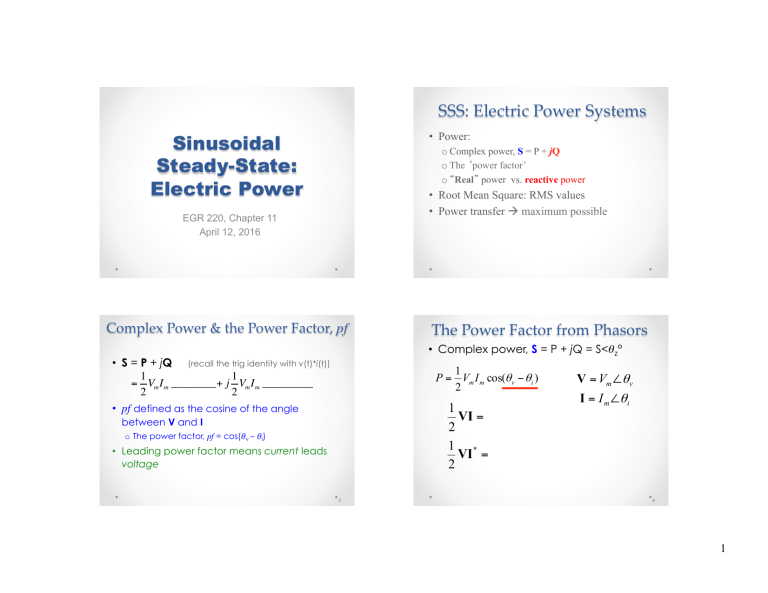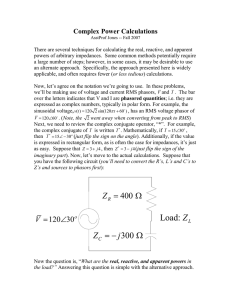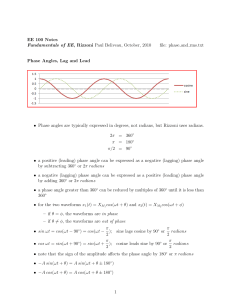Electric Power terms
advertisement

SSS: Electric Power Systems Sinusoidal Steady-State: Electric Power • Power: o Complex power, S = P + jQ o The ‘power factor’ o “Real” power vs. reactive power • Root Mean Square: RMS values • Power transfer à maximum possible EGR 220, Chapter 11 April 12, 2016 2 Complex Power & the Power Factor, pf The Power Factor from Phasors • Complex power, S = P + jQ = S<θz° • S = P + jQ (recall the trig identity with v(t)*i(t)) 1 1 = Vm I m ________+ j Vm I m _________ 2 2 • pf defined as the cosine of the angle 1 P = Vm I m cos(θ v − θ i ) 2 1 VI = 2 1 * VI = 2 between V and I o The power factor, pf = cos(θv – θi) • Leading power factor means current leads voltage 3 V = Vm ∠θ v I = I m ∠θ i 4 1 Complex Power: The Power Triangle Discussion - Important Angles: Ø What is the connection between 1. Phase angle of impedance, Z Z = R + jX 2. Phase difference between V & I 3. Relative values of P & Q Z= V Vm∠θV Vm = = ∠ (θV − θ I ) = Z∠θ Z I I m∠θ I I m 6 7 Check RMS at an Outlet Example: Power Factor o Find the power factor and state if it is leading or lagging, X rms = 1 T ∫ T 0 x 2 dt = Xm 2 € 8 9 2 RMS = Root Mean Square RMS: Root Mean Square • Most electrical equipment has two ratings o Maximum power, energy, current, voltage... o Average or sustained power, energy, current... • RMS is also referred to as the effective value • The effective value of an ac signal IS the dc value that delivers the same average power to a resistor • Maximum value o Instantaneous value è time domain • Average value o Phasor domain o RMS è a new ‘average’ measurement (the effect of the AC signal is equivalent to a DC signal at the RMS value) 10 11 Maximum Average Power Transfer • For circuits with complex impedance, when does maximum power transfer occur? Z L = RL + jX L = RTh − jX Th = Z *Th € 12 14 3 Summary • Power is defined with multiple methods, depending upon the problem at hand o Instantaneous power o Average power o Phasors – amplitude (peak) and phase angle o RMS value o Complex power and power factor • Complex power = real power + reactive power • S = P + jQ • Maximum average power transfer important in power systems 15 16 Summary: Representing Power • Know which concepts and terms are time domain vs. phasor domain • Know the definition and significance of: o o o o Instantaneous power Average power RMS vs. maximum value Complex power • Real power • Reactive power o Power factor o Compensation (pf correction) 17 4





